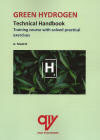
Hydrogen in not found free in nature. We have the example in water whose molecules results from the union of two hydrogen atoms with one oxygen. Returning to the case of water, if we want to separate its components, it can be done by electrolysis. But the basic question is that the electrolysis process requires energy, which is obtained through electricity generated in thermal, nuclear, etc. Another example, methane (CH4), can be used to make hydrogen, but it is a polluting fossil source. And this is where the concept of GREEN HYDROGEN comes in: it is that which is obtained through renewable energies (wind, solar, etc.), with zero polluting emissions. This work is of great interest to engineering companies, energy companies, construction companies, installers, designers, electrical companies, energy agencies, state companies, official bodies, etc. It is also very suitable for training courses. ÍNDICE COMPLETO DEL LIBRO Chapter 1 GREEN HYDROGEN. 1.- Definition. 2.- Renewable hydrogen. 3.- Hydrogen: a versatile energy. 4.- Low carbon footprint hydrogen with CO2 capture. 5.- Renewable hydrogen: electrolysis from water and renewable energy. 6.- Other ways of producing renewable hydrogen. 7.- Mobility and electricity generation. 8.- An adequate regulatory framework. 9.- Green hydrogen: an alternative to reduce polluting emissions. 10.- Advantages and disadvantages of green hydrogen. 11.- Practical exercises. Solutions at the end of the book. Chapter 2 HYDROGEN ROADMAP: A COMMITMENT TO RENEWABLE HYDROGEN. 1. Introduction. 2.- The national context. 3.- Stages of the hydrogen value chain. 4.- Production. 5.- Storage and transport. 6.- Final uses. 7.- Vision 2030. 8.- Vision 2050. 9.- Practical exercises. Solutions at the end of the book. Chapter 3 HYDROGEN AS AN ENERGY SOURCE. 1.- Hydrogen: presence on earth and in the universe. 2.- Properties of hydrogen. 3.- Hydrogen from the energy point of view. 4.- Hydrogen for energy transport. 5.- Hydrogen isotopes. 6.- Fuel cells. 7.- Practical exercises. Solutions at the end of the book. Chapter 4 METHODS FOR OBTAINING HYDROGEN. 1.- Compounds with hydrogen. 2.- Methods to obtain hydrogen. 2.1.- Electrolysis. 2.2.- Refurbished (stationary and vehicle applications). 2.3.- Gasification. 2.4.- Thermochemical cycles. 3.- Hydrogen storage methods. 4.- From solar energy. 5.- New technology for the production of clean hydrogen. 5.1.- The RGH2 OSOD system. 6.- Production of hydrogen from water. 7.- Breaking of the water molecules. 8.- Practical exercises. Solutions at the end of the book. Chapter 5 APPLICATIONS OF HYDROGEN. 1.- Current applications. 2.- Hydrogen in vehicles. 3.- Applications of hydrogen (Abelló Linde). 4.- Industrial applications of hydrogen (APPICE). 5.- Hydrogen as fuel. 6.- Practical exercises. Solutions at the end of the book. Chapter 6 FUEL CELLS. 1.- Definition. 2.- Operation of fuel cells. 3.- Conductivity of fuel cells. 4.- Differences between fuel cells and batteries. 5.- APPICE information on fuel cells and their operation. 6.- Factors that influence the operation of fuel cells. 7.- Useful life of fuel cells. 8.- Practical exercises. Solutions at the end of the book. Chapter 7 TYPES OF FUEL CELLS. 1.- Types of fuel cells. 2.- Phosphoric acid fuel cells. 3.- Batteries with a proton exchange membrane. 4.- Alkaline fuel cells. 5.- Solid oxide fuel cells. 6.- Mixed carbonate fuel cells. 7.- Methanol fuel cells. 8.- Proton ceramic fuel cells. 9.- Clostridium bacteria to generate hydrogen. 10.- Reversible fuel cells. 11.- Efficiency of fuel cells. 12.- Fuel cells according to their application. 13.- Practical exercises. Solutions at the end of the book. Chapter 8 FUEL CELL APPLICATIONS. 1.- Main applications. 2.- Fuel cells in space applications. 2.1.- Beginnings of the use of fuel cells in space. 3.- Fuel cells and the environment. 4.- Fuel cells in the automotive industry and electronics. 5.- Reformers. 6.- Loss of the environmental benefits of fuel cells. 7.- Practical exercises. Solutions at the end of the book. Chapter 9 HYDROGENERS AND FUEL CELL-MOVED VEHICLES. 1.- The hydrogen refueling stations. 2.- Sections of a hydrogenerator. 3.- Specifications of a vehicle powered by hydrogen. 4.- Extract from the European Regulation regarding the approval of hydrogen-powered vehicles. 4.1.- Definitions referring to vehicles powered by hydrogen. 5.- Practical exercises. Solutions at the end of the book. Chapter 10 FORECASTS ON THE FUEL CELL MARKET. 1.- Towards an economy based on hydrogen. 2.- Forecasts on the fuel cell market. 3.- World leaders in fuel cell research. 4.- Fuel cells and the European Union. 5.- Fuel cells in Spain. 6.- Practical exercises. Solutions at the end of the book. Chapter 11 NUCLEAR FUSION AND HYDROGEN. 1.- Nuclear fission and fusion. 2.- Hydrogen in nuclear fusion. 3.- Base reaction of nuclear fusion. 4.- Release of energy in nuclear fusion. 5.- Hot fusion and the ITER experimental reactor. 6.- Confinement of nuclear fusion. 7.- Spain and nuclear fusion. 7.1.- The National Fusion Laboratory (CIEMAT). 8.- Practical exercises. Solutions at the end of the book. Annex 1 GLOSSARY OF ENERGY TERMS. PRACTICAS EXERCISES. SOLUTIONS.
- ISBN: 9788412643374
- Editorial: MADRID VICENTE, Ediciones
- Encuadernacion: Rústica
- Páginas: 204
- Fecha Publicación: 01/03/2023
- Nº Volúmenes: 1
- Idioma:
